HyperGraph Cryptocurrency: What It Is, How It Works, and Where to Find It
When people talk about HyperGraph cryptocurrency, a blockchain project that uses graph-based data structures to manage transactions and smart contracts more efficiently. It's not just another coin—it's a shift in how blockchain networks handle relationships between data points. Unlike traditional blockchains that chain blocks in a linear line, HyperGraph organizes information like a web of connected nodes. Think of it like a social network where every user, transaction, and contract is a point, and the connections between them tell the real story. This structure can make scaling faster and reduce congestion, which is why some developers are betting big on it.
HyperGraph isn’t just a coin—it’s a blockchain graph technology, a method of storing and verifying data using interconnected nodes rather than sequential blocks. Also known as graph-based blockchain, it’s used in projects trying to solve the trilemma of speed, security, and decentralization. This approach relates closely to decentralized network, a system where control is spread across many nodes without a central authority. Also known as peer-to-peer ledger, it’s the backbone of most crypto systems, but HyperGraph takes it further by mapping how those nodes interact. You’ll find this tech in experimental DeFi platforms, identity systems, and even AI-driven market prediction tools. It’s not mainstream yet, but it’s showing up in niche projects that need to process complex data fast.
What makes HyperGraph different? Most crypto coins rely on simple account balances or token transfers. HyperGraph tracks how those transfers connect—like who paid whom, which smart contracts triggered, and which wallets were involved in a chain of actions. This lets developers build smarter automation, detect fraud patterns, and even predict liquidity shifts before they happen. It’s not magic—it’s math. And it’s being tested in real systems, even if you haven’t heard of them yet. The posts below cover exactly that: projects using graph-based tech, tokens tied to this structure, and the teams building them. Some are live. Some are dead. Some are wild experiments. You’ll see what’s real, what’s risky, and what’s just noise.

